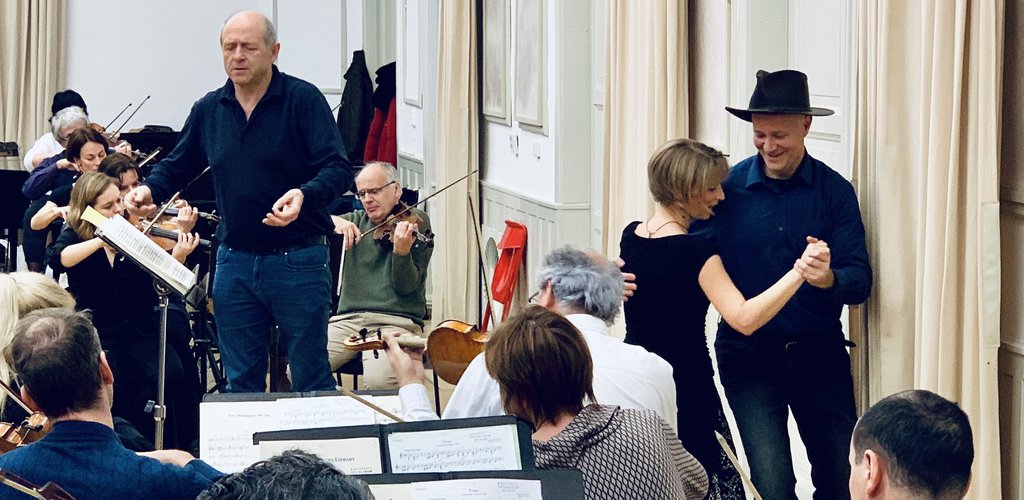Two pairs of dancing feet, singing musicians and a totally crushing Rite of Spring. So the Festival Orchestra filled Müpa on three nights.
I do love the way the Festival Orchestra always has an idea. You would think it wouldn’t take a genius to come up with the idea of having the orchestra start to play before the conductor arrives on stage – sparing the embarrassing obligatory ritual of take bows, applause, and tactical last-second coughing and throat clearing. When Iván Fischer appears at the beginning of the Stravinsky concert, the first, march-like movement of Four Norwegian Moods, entitled Intrada, has already started, cued in by concert master Tamás Major. So finally it turns out that András Schiff’s postulate in his book of conversations that we need silence to be able to create music, is not necessarily true; the Festival Orchestra shows that if you want music to be born, you need to play music. With joy.
Neither is it a big idea to start dancing while the orchestra is playing Tango, the short character piece, but this is exactly what second violinist Noémi Molnár and Zoltán Fekete from the viola section do. Or, actually, it is a big idea, since, strange as it may sound, classical music podiums rarely witness similar feisty and sexy things happen. But here it is: all you need to enthral the audience is two musicians with gifted legs, plus one black hat.
This was followed by a truly inspired performance of Symphony of Psalms, an unusual, although also one of the most popular pieces in Stravinsky’s oeuvre. The composer, who was at least as much the chameleon of 20th century classical music as were the Beatles or Bowie of pop music, often has an intimate and personal voice here. The short cello solo of the first movement and the ecstatic forte of the chorus (“Remitte mihi” – forgive me) are heart wrenching. The oboe opening the double fugue of the second movement seems abandoned and the second theme of the chorus, the thickening polyphonic texture whirls unpeacefully. Then I have an interesting question: Why is the closing part – “He hath put a new song in my mouth” – hostile, almost violent? Maybe because we are still before the rapture that will happen in the third movement?
I have always delighted in the dedication written on the manuscript of the Symphony of Psalms reading “Composed for the glory of God and dedicated to the Boston Symphony Orchestra”, as if Stravinsky said, OK, you are the Lord in Heaven, but let us musicians decide on questions of music. Before readers gasp at this as a deliberate misinterpretation, they should have a look at the third movement, where homophonic choral writing contrasts sharply with the rhythmic and harmonic liberty of modernity. (A few passages seem to conjure up Sacre, and a motif of four notes can even be heard.)
This music tries to reconcile the two levels of the world: the divine and the human.
It was inspired, as told by Stravinsky, by Elijah’s chariot, whose ascending into the heavens is described by a dramatic passage with triplets. Laudate, sings the chorus, but the harmony cannot smoothly shift into the major key, and the melody also tends to descend. Then the words of Psalm 150 come to life with noisy fanfares and at a great volume, but the movement is closed by the floating sounds of the chorus, emanating peace. Stravinsky himself pointed out how inseparable the unity of the chorus and the orchestra was in this cantata, and the Festival Orchestra found an excellent partner in Cantemus Mixed Choir. In the dark colours of the orchestra playing without violins, violas or clarinets, the tone of the chorus – emotional but also echoing eternity – was the mysterious component.
The mammoth piece of the Festival Orchestra’s concert was, of course, The Rite of Spring, this enduring work still having its elemental force. Although the myth surrounding its premiere seems to have been debunked, it is a piece of ballet music that still appears outrageously modern. Physicality and movement are inseparable parts of the music, even if now – and usually – it is performed as a concert piece. Need I say how diverse the different interpretations of a composition using such extreme characters can be? (The recordings of Valerij Gergiev, Igor Markevich or Simon Rattle should not be missed.) The Rite of Spring of the Budapest Festival Orchestra was a crushing experience. The key to their performance seemed to be that the conductor let the parts live and breathe independently, and the resulting heterogeneity and complexity absorbed the audience. Although this was a fairly brisk performance (I felt it faster, but my watch said 38 minutes), the slow parts sounded definitely protracted. But that only enhanced the performance: we discovered deeper layers of the music and the audience was more impressed by the phrases spiralling into cacophony. Iván Fisher allowed the instrumental parts to sound loud when needed, or, at other times, suffering or passionate, like the trumpet blaring high, the horns and the timpani.
What makes this music so exciting more than a hundred years after its premiere? Maybe this: The BFO provided a virtuoso interpretation of the ballet music, and I was perfectly happy with it.
If I listen to Gergiev’s recording, I can hear the shaman guiding me in the dark, if I attend Fischer’s concert, I can hear the raw force, which does not mystify itself but simply tears my head off.
Those who were in a hurry and left the concert hall before the encore should regret it: the orchestra was transformed into a choir to sing the Russian composer’s Ave Maria I do love the way the Festival Orchestra always has an idea.
